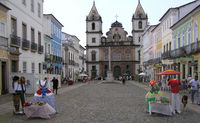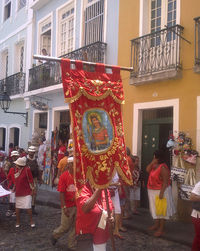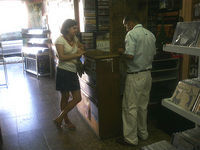Message from Brazil4 - National Samba Day
Tagged with: Samba Bahia Brazil Salvador Pelourinho Mercado Cultural Sinho Ary Barroso Na Baixa do Sapateiro Luis Monteiro de Costa Black Style Chuva de Perereca Tessa Burwood WorldMusic.co.uk world music pagode
December 2nd was O Dia Nacional do Samba (National Samba Day). I missed it, having just arrived here, and wanted to find out more about it, so I've been doing some research, and asking around. Its origins and motives make an interesting comparison to the Mercado Cultural music festival.
Mercado Cultural is a really interesting concept for a festival – the culmination of a year-round caravan of musicians, producers, managers and cultural representatives from various genres, who travel throughout Brazil and abroad, to perform, discuss and disseminate their work. The aim is to explore the challenges of maintaining a truly fruitful intercultural dialogue. Beyond race and language, this caravan also unites people across the most obvious, yet nuanced and difficult barrier we face today – the socioeconomic divide.
Here in Brazil, this divide is much more difficult to cross, although in recent years the expanding middle class has begun to link the two uncomfortably coexisting worlds – the very rich minority, and the penniless majority. Sharing music is a fascinating, at times problematic, but ultimately positive method of bringing these worlds together. Brazil is, after all, synonymous with samba, and samba evolved from the work songs and spirituals sung by African slaves in Bahia. As I briefly touched on in the previous article, it was the influx of poor Bahian workers into Rio during the late 19th – early 20th century that first brought samba to the ears of well off, white Brazilians.
Sinhô and his contemporaries became the intermediaries between these two cultures, because they were tacitly accepted by both worlds. That said, a good measure of prejudice has always tempered this upper class fascination with samba. Sinhô's derogatory comments on Bahian people, and his willingness to appropriate their music while taking the credit, polarise the dividing line between Bahia and Rio, rich and poor, black and white, through cold rejection.
But there is another, more subtle and ultimately sinister way to exclude a culture, and that is to exoticise and objectify it. While Sinhô stole from Bahian samba singers and claimed their songs for himself, while openly criticising what he saw as an uncultured and backward Bahian race, his contemporary and neighbour Ary Barroso described a scene of sexual longing between a white woman from Rio and a dark skinned man from Salvador, in a city he had never seen. "Na Baixa do Sapateiro" is the story of a woman looking for love in Salvador. She meets a dark skinned Bahian man lazing in the shade in Baixa do Sapateiro, and tries unsuccessfully to seduce him.
Now a busy shopping district between Pelourinho, Saude and Barroquinha, Baixa do Sapateiro was, at one time, the home of an Italian shoe manufacturer – hence the name ('sapateiro' means shoemaker). It's fame spread throughout Brazil when three cinemas ran there simultaneously, and Ary Barroso (who wrote music for film) presumably identified with the area, despite not setting foot in Bahia, let alone Salvador, until years later. Here's a translation of the samba he wrote:
Bahia, happy dark skinned land,
I miss you like mad!
Our Lord of Bomfim,
Find me another man with dark skin
Just the same, just for me.
In Baixa do Sapateiro
I came across one day,
A lazy dark skinned man from Bahia
I asked him for a kiss, he refused
An embrace, and he just smiled
I asked for his hand
He would not give it
And ran away...
Bahia, happy dark skinned land,
I miss you like mad!
Our Lord of Bomfim,
Find me another man with dark skin
Just the same, just for me.
In the 1940s, this samba's fame spread to the ears of a local councillor in Salvador, whose name was Luis Monteiro da Costa. Inspired by the song – or perhaps frustrated, who knows - he founded O Dia Nacional do Samba (National Samba Day.) This day falls on December 2nd, and was originally only celebrated in Salvador – in recognition of samba's origin. More recently, it became a national holiday, and is now celebrated across Brazil.
Meanwhile, 'Na Baixa do Sapateiro' entered decisively into the Brazilian canon, interpreted by famous singers like Elis Regina and João Gilberto. It is emblematic of a vision of Bahia repeated in Brazilian popular music – that Bahian people are docile, lazy and sexually available. Although in the case of this samba, the Bahian man refused such advances, there's something sinister in the air here in Salvador. Sex tourism is rife here, and male prostitution is particularly noticable.
I walk through Terreiro de Jesus in Pelourinho, past the men practicing capoeira in the square and calling out to female tourists. In Praça da Sé, a leather skinned Italian woman drags a local mixed race guy by the hand into the entrance of a hotel. In Baixa do Sapateiro, I hear music blasting from speakers on a pirate CD salesman's truck: a song from Bahian pagode star Black Style's latest album (eponymous), called "Chuva de Perereca" (‘It’s Raining P**sy’). On the front cover of the CD, Black Style sings to a stadium packed out with screaming female fans. I feel quite embarrassed – more of a prude than I thought :)
Tessa Burwood for WorldMusic.co.uk
Festa de Santa Barbara - Photos
Tagged with: Junior Rocha Santa Barbara Salvador Brazil Bahia Rosario dos Pretos Barroquinha Candomble Umbanda Caruru Iansa Ogum Pelourinho orixas Xango
Here are some photos taken at the annual Festa de Santa Barbara, Pelourinho, Salvador, Brazil, to go with the blog below - "Message from Brazil 2 - Viva Santa Barbara (Que Viva Xangô)" - taken by Junior Rocha.
1 The Sao Francisco Church and crossroads
2 Typical Bahian Costumes
3 A 'bahiana' in typical costume
4 Two more Maes da Santo
5 Young girl in bahian costume
6 Statue of St Lazarus being carried on a bed of flowers
7 Mass in the Square
8 Participants in the procession
9 Participants in the procession
10 The Flag of Santa Barbara
Message from Brazil 2 - Viva Santa Barbara! (Que Viva Xangô!)
Tagged with: Santa Barbara Salvador Brazil Bahia Rosario dos Pretos Barroquinha Candomble Umbanda Caruru Iansa Ogum Oaxaguia Pelourinho orixas Xango
On December 4th each year, 'soteropolitanos' (people from Salvador) devoted to Catholicism, Evangelism, Candomble, Umbanda and various other religions come together to celebrate A Festa de Santa Barbara - one of the most popular festivals of Salvador's religious calendar. Today's the day, and it's RIDICULOUSLY HOT! I may actually melt, but hearing about the snow back home, reckon I should keep schtum!
The day begins early at 5am with fireworks at dawn, (I missed this part, for some reason), then there's a mass at Igreja de Nossa Senhora do Rosário dos Pretos (Our Lady of the Black People's Rosary), at 7am.
So many people come from across the city to pray that another mass is then held outside in the square. Here, devotees of Santa Barbara are joined by tourists, street vendors, camera crews and reporters, and almost everyone is wearing bright red and white. These are Santa Barbara's colours, and I wish I'd known - I felt a little embarrassed dressed in green and brown!
In Catholic hagiography Saint Barbara was a Greek who was tortured, mutilated and made to walk naked through the streets, and eventually executed by her own father Maximino Dioscoro, after he discovered her conversion to Christianity. On her way to the prison cell, Barbara asked her guards to break off a cherry tree branch that was yet to flower. She spent the days before her death praying and talking to the angels that she saw in her cell, and on the seventh day, the cherry branch burst into bloom. Barbara took this as a sign that she had chosen the right path, and went calmly to her beheading. Legend has it that the moment her head fell from her body under the axe, a beam of bright light or maybe lightning speared her father from above, killing him instantly.
Santa Barbara is the patron saint of firefighters, so naturally the procession takes a pit stop at the fire station in Barroquinha. She also looks after mountaineers and geologists - I guess there aren't any climbing walls or universities en route. As far as I know, revellers and devotees do not take it in turns to slide down the pole, but in my head that's what happens - I may write a letter to the local council and suggest the idea, what do you reckon?
When the procession arrives at Santa Barbara Market, the crowd is served with a traditional candomble dish called caruru. Made from okra, hot peppers, dried shrimp and palm oil, this simple and tasty dish is made in enormous amounts by communities throughout the city in the run up to December 4th, and there are hotly disputed contests to see who can cook the most, as their sign of devotion to the saint.
[Editor’s note: Santa Barbara is however also synonymous with the Warrior God, Xangô, of the Yoruba-derived afro-latin religions Candomble and Umbanda; Xangô’s colours are Red and White and he is also the orixa of Thunder and Lightning and virility, likes okra, and wields weapons such as the sword (like Barbara) and in particular the Double-Headed Axe; Xangô is an incredibly popular orixa (being the god of Music and Dance) especially with latin percussionists!].
Intermingled with the figure of Xangô/Santa Barbara is the Candomble goddess Iansã (orixa of hurricane and change). According to one legend, Iansã was once the wife of the blacksmith Ogum, who served Oxaguiã - a powerful king who reigned over an enormous and much disputed land. At Ogum’s side, Iansã's powerful breath fed the flames of his forge, so that he could make enough arms for King Oxaguiã to win wars against his enemies. When Oxaguiã paid an honorary visit to Ogum, to congratulate him for his war efforts, he fell instantly in love with the beautiful Iansã, and seduced her into leaving her husband to join him in his castle.
When war came again to Oxaguiã's kingdom, he returned to the blacksmith in need of more arms. Ogum protested that without Iansã by his side, forging so many swords would prove impossible, but the king reassured him that he could fix it. Returning home, he made his stolen mistress climb the highest tower of the castle, from where Iansã found the courage to blow so hard that her breath became a wind, before which the entire kingdom lay prostrate, as Ogum set to work above the fires of his now blazing forge, on the other side of the city. Her breath arrived at his forge at exactly the correct amount to fan the flames. The weapons were made, the war was won, and the king was happy. Not happy enough, apparently, to return Iansã to her rightful and deserving husband, but there's something quite refreshing about an ancient legend involving open and complicit relationships, don't you think?
Anyway, the procession is still going on outside, in fact there are several cavalcades of dancers, brass bands and giant puppets parading around Pelourinho - and more red lycra than you could shake your booty at. I'm off across town to get my some hearty food, outside of this craziness - I feel a plate of caruru and a cheeky slide down the fireman's pole coming on!
Tessa Burwood for WorldMusic.co.uk
Message from Brazil 1 - Vinyl Pelourinho
Tagged with: Brazil Pelourinho Bahia Salvador Planet Music Ajuda 39 MPB musica sertaneja forro samba bossa nova Caetano Veloso Ce Eterna Dimensao Zeca Pagodinho Tessa Burwood WorldMusic.co.uk World Music
This is the first report from our own correspondent Tessa Burwood who's currently out in Brazil. Tess will be sending in her reports as to what she sees, muses and gets up to over the next three weeks. In this one she's arrived in the city of Salvador in Bahia, Northern Brazil (traditionally cited as the most African of all Brazilian states) and set up base in the old slave area of Pelourinho, one of the most culturally vibrant areas of the city:
"Who said music shops were dead?"
"Who said music shops were dead? Planet Music and Ajuda 39 in Pelourinho are in a healthy state.
Avelar began working at Planet Music as a kid, because he spent so much time in there flicking through records that the shop assistant told him to go speak to the boss:
"From shop rat to boss via passion for music - I love my job!"
There's an exhaustive collection of MPB, musica sertaneja, forro, samba, everything you can think of when it comes to the music loving public that pass through Pelourinho. Apparently, the French always ask for bossa nova,
"Just as elegant as they like to think they are," says Avelar with a wry grin.
"German tourists don't like Brazilian music at all. They only buy CDs as presents for the folk back home, hardly even look at the covers or ask any questions. What can I say? They just don't dig us!"
Avelar's favourites include Pink Floyd and Kraftwerk, he knows all the dates of birth of everyone in the former, and listened to the latter when, during the Cold War the airwaves were flooded with American music, and anything deemed transgressive was contraband.
He was pleased to tell me that Caetano Veloso recently made up 500 copies of his seminal album "Ce" on vinyl for his closest 500 friends. Sony have opened a vinyl production unit down south, apparently.....
Round the corner at Ajuda 39, it's a vinyl purist's heaven - as you can see from the photos. Tekko works behind the counter by day and plays samba by night in a band called Eterna Dimensao. They're playing on Sunday in Rio Vermelho, I'm going to check them out. I asked him what was his favourite record in the whole shop, and it seemed he'd been mooning over it all afternoon! Zeca Pagodinho :)
Tomorrow, percussion class at 2pm, who knows where my rhythm's at?! "
Tessa Burwood for WorldMusic.co.uk
[There will be more from Tessa as she moves around Brazil in the next three weeks, including a trip to the remote settlement of São Braz in Bahia state to check out a village whose entire culture has been officially protected by the United Nations. Stay tuned.]
1































